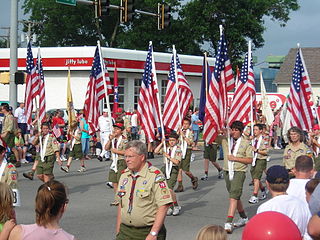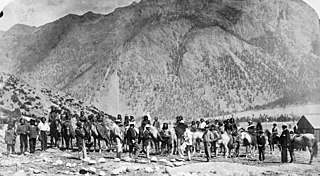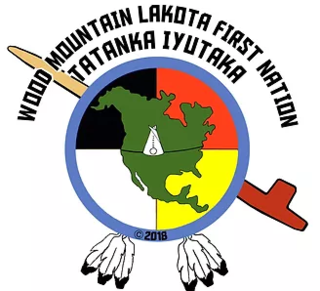
The United Nations (UN) is an intergovernmental organization aiming to maintain international peace and security, develop friendly relations among nations, achieve international cooperation, and be a centre for harmonizing the actions of nations. It is the world's largest and most familiar international organization. The UN is headquartered on international territory in New York City, and has other main offices in Geneva, Nairobi, Vienna, and The Hague.

The United Nations Security Council (UNSC) is one of the six principal organs of the United Nations (UN), charged with ensuring international peace and security, recommending the admission of new UN members to the General Assembly, and approving any changes to the UN Charter. Its powers include establishing peacekeeping operations, enacting international sanctions, and authorizing military action. The UNSC is the only UN body with the authority to issue binding resolutions on member states.
The Cree are a North American Indigenous people. They live primarily in Canada, where they form one of that country's largest First Nations.

Scouting in Oklahoma has a long history, from the 1910s to the present day, serving thousands of youth in programs that suit the environment in which they live.

The Navajo Nation is a Native American territory covering about 17,544,500 acres, occupying portions of northeastern Arizona, northwestern New Mexico and a smaller portion covering southeastern Utah, in the United States. This is the largest land area retained by a Native American tribe in the United States. In 2010, the total population of Navajo tribal members was 332,129 with 173,667 living within the boundaries of the reservation and 158,462 tribal members outside of the reservation. Metropolitan areas accounted for 26 percent of the population, border towns accounted for ten percent, and the remaining 17 percent were living elsewhere in the U.S. The seat of government is located in Window Rock, Arizona.

The Ojibwe, Ojibwa, Chippewa, or Saulteaux are an Anishinaabe people in what is currently southern Canada, the northern Midwestern United States, and Northern Plains.

The Mississauga are a subtribe of the Anishinaabe-speaking First Nations peoples located in southern Ontario, Canada. They are closely related to the Ojibwe. The name "Mississauga" comes from the Anishinaabe word Misi-zaagiing, meaning "[Those at the] Great River-mouth." It is closely related to the Ojibwe word Misswezahging, which means ‘a river with many outlets.’

The Stʼatʼimc, also known as the Lillooet, St̓át̓imc, Stl'atl'imx, etc., are an Interior Salish people located in the southern Coast Mountains and Fraser Canyon region of the Interior of the Canadian province of British Columbia.
The Anishnabek Nation, also known as the Union of Ontario Indians, is a First Nations political organization representing 40 member Anishinaabe First Nations in the province of Ontario, Canada. The organization's roots predate European contact in the 16th century, in the Council of Three Fires. The Union of Ontario Indians was incorporated in 1949 to serve as a political advocate and secretariat for the Anishinabek First Nations, the indigenous peoples speaking Anishinaabe languages in Ontario. In 2017, the Council changed its identification using the name "Union of Ontario Indians" only for legally-binding agreements but for all other purposes referred to themselves as Anishinabek Nation. The head office for the Union of Ontario Indians is located at Nipissing First Nation near North Bay, Ontario.
Thunderchild First Nation is an independent Cree First Nations band government in Turtleford, Saskatchewan, Canada with no affiliation with any Tribal Council. It is located approximately 113 kilometers northwest of North Battleford. European settlement in 1909 caused the reserve to be moved by the Government of Canada from its original location near Delmas, Saskatchewan to where it now currently resides near Turtleford, Saskatchewan.
Fort McMurray First Nation is a Cree and Chipewyan band government located near Fort McMurray, Alberta. It is a member of the Athabasca Tribal Council and a Treaty 8 nation. The Athabasca Tribal Council represents 5 First Nation bands in northeast Alberta. Fort McMurray First Nation is governed by a Chief and two councillors.
Naotkamegwanning First Nation, formerly known as Whitefish Bay First Nation and known in the Ojibwe language as Ne-adikamegwaning, is an Ojibwa or Ontario Saulteaux First Nation located in Kenora District, Ontario near Sioux Narrows of Lake of the Woods.
Northwest Angle 33 First Nation is an Ojibwe or Ontario Anishinaabe First Nation band government who reside in Kenora District, Ontario near Sioux Narrows of Lake of the Woods.

The James Smith First Nation is a Plains Cree Aboriginal band government whose reserve is north of Melfort, Saskatchewan, Canada. James Smith has one reserve Fort à la Corne #100 located north of Kinistino near Fort de la Corne on the Saskatchewan River. This reserve is shared between three first nations, the other two being the Peter Chapman First Nation and Chakastaypasin First Nation. James Smith has a present population of 2,412, with the on-reserve population estimated to be at 1,592 members. James Smith is part of the Prince Albert Grand Council. Bordering the reserve are the rural municipalities of Kinistino No. 459 and Torch River No. 488, as well as the Cumberland 100A reserve.

The Whitesand First Nation is an Ojibway First Nation reserve in Northern Ontario, Canada. They have reserved for themselves the 249-hectare (615-acre) Whitesand reserve. The community of Armstrong Settlement is their main community, located coterminously with Armstrong, Thunder Bay District, Ontario. In June 2008, their total registered population was 1086 people, of which their on-reserve population was 311.
The Bingwi Neyaashi Anishinaabek is an Ojibway First Nation Band government in Northwestern Ontario, Canada.
Ojibways of Onigaming First Nation is an Ojibwe or Ontario Saulteaux First Nation located in Kenora District, Ontario near Nestor Falls, Ontario. Together with the Big Grassy First Nation, Ojibways of Onigaming First Nation is a successor apparent to the former Assabaska Band of Saulteaux. Total registered population in February, 2012, was 737, of which the on-reserve population was 445. The First Nation is a member of the Anishinabeg of Kabapikotawangag Resource Council, a regional tribal council that is a member of the Grand Council of Treaty 3.
Saulteaux First Nation is an Anishinaabe First Nation band government, whose reserves are located near Cochin, Saskatchewan. In February 2012, the First Nation had a total of 1,225 registered members, of which 604 lived on their own reserve.

Birch Narrows Dene Nation is a Dene First Nation band government in the boreal forest region of northern Saskatchewan, Canada. It is affiliated with the Meadow Lake Tribal Council (MLTC).

The Wood Mountain First Nation is a Lakota First Nations band government in southern Saskatchewan, Canada. Led across the border by Sitting Bull, they are the only organized Lakota nation in Canada. Their reserve is located at Wood Mountain 160, near Grasslands National Park, although most members reside elsewhere.










